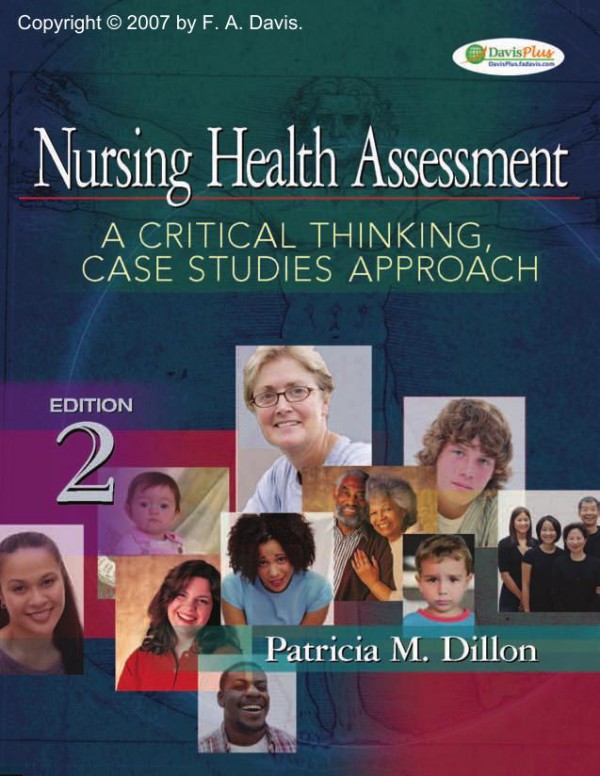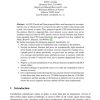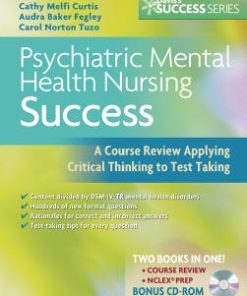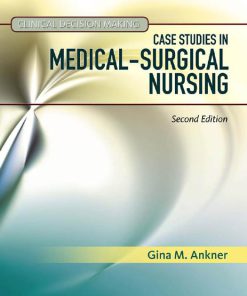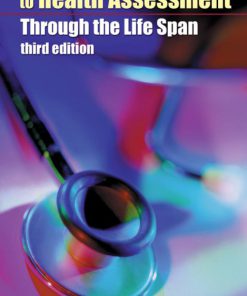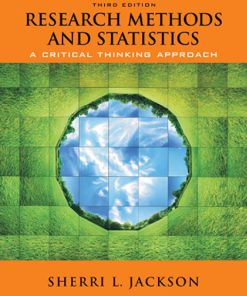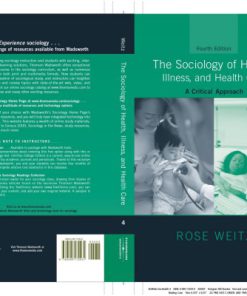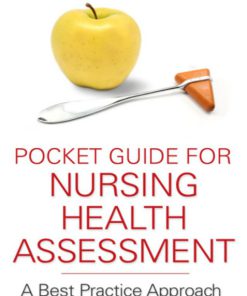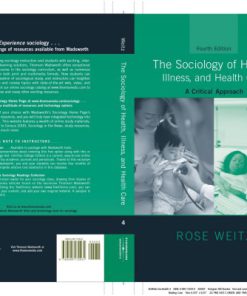Nursing Health Assessment A Critical Thinking Case Studies Approach 2nd Edition by Patricia M Dillon ISBN 0803615795 9780803615793
$50.00 Original price was: $50.00.$25.00Current price is: $25.00.
Authors:Unknown , Author sort:Unknown
Nursing Health Assessment A Critical Thinking, Case Studies Approach 2nd Edition by Patricia M. Dillon – Ebook PDF Instant Download/Delivery. 0803615795, 9780803615793
Full download Nursing Health Assessment A Critical Thinking, Case Studies Approach 2nd Edition after payment
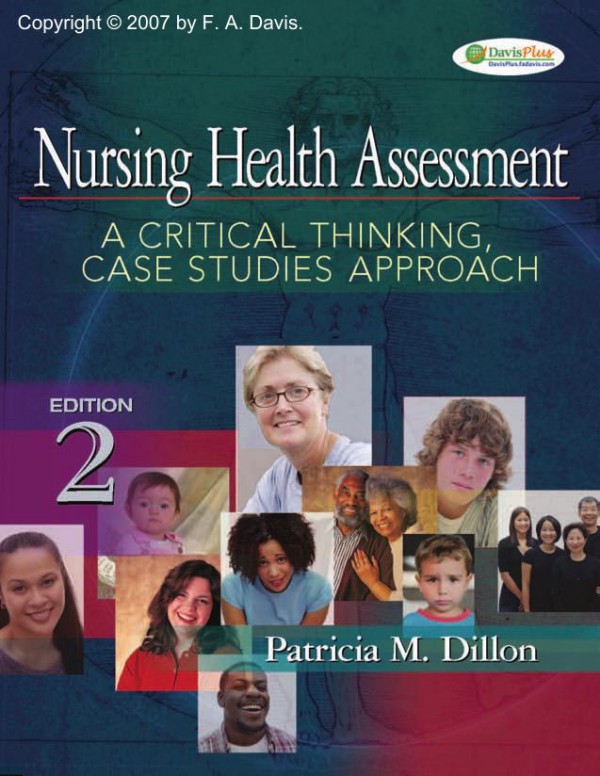
Product details:
ISBN 10: 0803615795
ISBN 13: 9780803615793
Author: Patricia M. Dillon
Learn, Do, and Think! Experience the Dillon Difference – engage your students in the assessment process! Throughout the text, you will find a unique body system integration, case studies strategically placed three times in each chapter, and critical thinking questions. Dillion Delivers! Patricia M. Dillon’s new 2nd edition of Nursing Health Assessment: A Critical Thinking, Case Studies Approach delivers what you’ve been asking for – an alternative to books that present health assessment as a collection of techniques with no integrated focus. Dillon delivers an innovative approach that engages students in the assessment process through three important retention-developing features: Body Systems Integration – outlined clearly in illustrations. Teaches your students to see the relationships among the various body systems. Case Studies – woven through the chapters. Gives meaning to the assessment and essentially states, “You are assessing this patient!” to your students. Critical Thinking – introduced up front and integrated throughout all the chapters. Asks your students to think as they learn the assessment process and to apply what they’ve learned. Dillon delivers in her updated 2nd edition with the key features (see below) that you wanted – features designed to make your students think, learn and do!
Nursing Health Assessment A Critical Thinking, Case Studies Approach 2nd Table of contents:
Section 1: Foundations of Health Assessment
-
Introduction to Health Assessment
- Definition and Importance of Health Assessment
- Overview of the Nursing Process
- The Role of the Nurse in Health Assessment
-
Critical Thinking in Health Assessment
- Developing Critical Thinking Skills
- The Relationship Between Critical Thinking and Clinical Judgment
- Applying Critical Thinking to Health Assessments
-
Cultural Considerations in Health Assessment
- Cultural Competency and Sensitivity
- Assessing Patients from Diverse Backgrounds
- Communication Strategies for Culturally Diverse Populations
-
Health History Taking
- Components of a Comprehensive Health History
- Techniques for Eliciting Patient Information
- Special Considerations for Pediatric, Geriatric, and Vulnerable Populations
Section 2: Physical Examination Techniques
-
Techniques of Physical Examination
- Inspection, Palpation, Percussion, and Auscultation
- Systematic Approach to the Physical Exam
- Tools and Equipment Used in Health Assessment
-
General Survey and Vital Signs
- Overview of the General Survey
- Measuring Vital Signs: Temperature, Pulse, Respirations, Blood Pressure, and Oxygen Saturation
- Documentation and Interpretation of Vital Signs
-
Assessment of the Skin, Hair, and Nails
- Common Skin Disorders and Their Clinical Features
- Hair and Nail Examination
- Clinical Case Study: Assessing for Skin Cancer
-
Assessment of the Head, Eyes, Ears, Nose, and Throat (HEENT)
- Techniques for Assessing the Eyes and Vision
- Otoscopic Examination and Ear Health
- Oral Cavity and Throat Examination
-
Cardiovascular System Assessment
- Inspecting and Palpating the Heart and Vascular Structures
- Auscultating Heart Sounds and Murmurs
- Case Study: Identifying Signs of Heart Failure
-
Respiratory System Assessment
- Inspection and Palpation of the Lungs and Chest
- Auscultating Lung Sounds: Normal and Abnormal Findings
- Case Study: Assessing for Pneumonia or COPD
-
Gastrointestinal System Assessment
- Techniques for Abdominal Examination
- Identifying Abnormal Findings: Bowel Sounds, Palpation, and Percussion
- Case Study: Abdominal Pain and Digestive Disorders
-
Musculoskeletal System Assessment
- Assessing Range of Motion, Strength, and Joint Health
- Special Tests for Joint and Musculoskeletal Disorders
- Case Study: Osteoarthritis vs. Rheumatoid Arthritis
-
Neurological System Assessment
- Evaluation of the Neurological Function: Mental Status, Cranial Nerves, and Reflexes
- Assessing Coordination and Motor Function
- Case Study: Neurological Deficits in Stroke
-
Lymphatic and Immune System Assessment
- Palpation of Lymph Nodes and Other Lymphatic Structures
- Assessing the Immune Response
- Case Study: Lymphadenopathy and Systemic Illness
-
Genitourinary System Assessment
- Inspection and Palpation of the Abdomen and Pelvic Area
- Examining the Genitalia: Male and Female Exams
- Case Study: Urinary Tract Infections and Kidney Disease
Section 3: Age-Specific Considerations
-
Pediatric Health Assessment
- Developmental Milestones and Pediatric Health History
- Pediatric Physical Examination: Techniques and Tips
- Case Study: Assessing a Child with Respiratory Distress
-
Geriatric Health Assessment
- Age-Related Changes in Health and Physical Examination
- Common Geriatric Syndromes and Their Assessment
- Case Study: Dementia and Functional Assessment in Older Adults
Section 4: Integrating Health Assessment with Clinical Reasoning
-
Clinical Reasoning and Problem-Solving
- The Role of Clinical Reasoning in Health Assessment
- Developing Diagnostic Thinking and Treatment Plans
- Case Study: Diabetes Management and Blood Sugar Control
-
Case Study: A Comprehensive Health Assessment
- Gathering Data, Analysis, and Formulating a Care Plan
- The Role of Evidence-Based Practice in Health Assessment
- Real-Life Clinical Scenarios for Practice and Reflection
Section 5: Special Considerations and Advanced Topics
-
Mental Health Assessment
- Tools for Assessing Mental Health and Cognitive Function
- Identifying Mental Health Conditions: Depression, Anxiety, and Psychosis
- Case Study: Assessment of a Patient with Acute Anxiety Disorder
-
Pain Assessment and Management
- Identifying and Measuring Pain: Tools and Techniques
- Acute vs. Chronic Pain Assessment
- Case Study: Pain Management in Post-Operative Care
-
Functional Assessment in Nursing
- Assessing Activities of Daily Living (ADLs) and Instrumental Activities of Daily Living (IADLs)
- Functional Status and Disability Evaluation
- Case Study: Assessing Functional Decline in the Elderly
-
Ethical and Legal Considerations in Health Assessment
- Confidentiality, Consent, and Patient Autonomy
- Ethical Dilemmas in Health Assessment
- Legal Issues in Documentation and Reporting
Section 6: Conclusion and Future Directions
- The Future of Health Assessment in Nursing
- Advances in Technology and Telehealth in Health Assessment
- The Role of Artificial Intelligence in Clinical Decision-Making
- Lifelong Learning and Professional Development in Health Assessment
People also search for Nursing Health Assessment A Critical Thinking, Case Studies Approach 2nd:
nursing health assessment a critical thinking
nursing health assessment a critical thinking case studies approach
what are the components of critical thinking in nursing
what is critical thinking in nursing
what are the critical thinking skills in nursing

